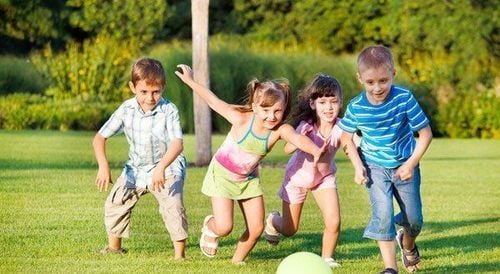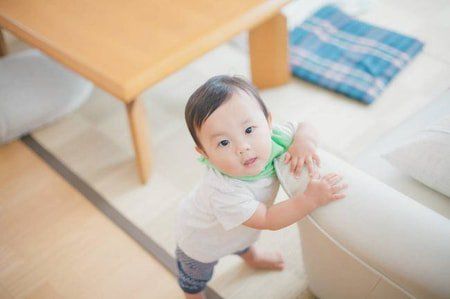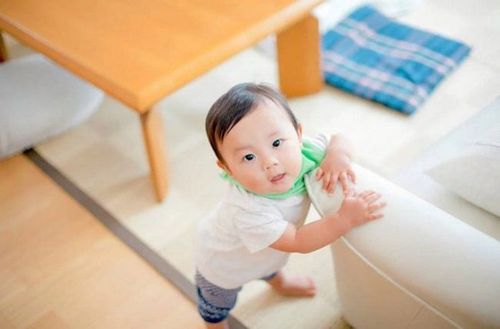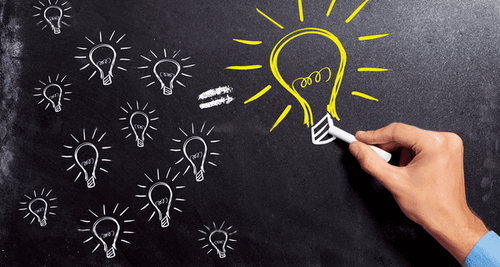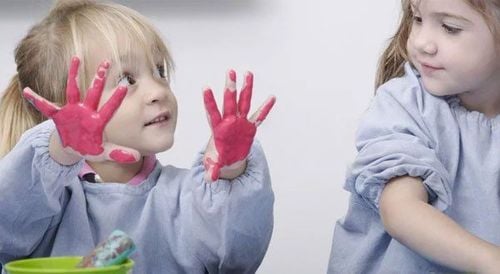This is an automatically translated article.
Children 5 - 6 years old is a period of preparation for the child's environmental change. At this time, children need to switch from playing mainly to learning to gradually get used to the primary school environment later. Children also need to practice daily tasks, develop memory and observation skills.
1. Brain structure of 5-6 year old children
During the first 3 years of life, a child's brain has grown to 80% of an adult's brain. And by the age of 5 or 6 years, the child's brain can grow to almost the same size as the adult brain in both size and volume. According to studies, although most brain development occurs during the first 3 years after birth, in the following years, the brain continues to nurture the ability of neurons to function strongly. strong. That stimulates and makes children learn very quickly, especially those between the ages of 3 and 6. Children not only learn the basics but can also understand social rules, generalize similar objects, know how to play sports and games with rules such as seahorses, chess. , can do some work, be creative, even children learn to make simple plans....
It's not necessarily with such strong brain development that children can Live and work like an adult. However, brain development at this age helps children explore, tolerate and apply knowledge to life thoroughly.
2. Psychological characteristics of 5-6 years old children
According to A.X Macarenco, a famous Russian educator: "The foundation of education is mainly built before the age of 5, it accounts for 90% of the quality of the whole educational process". And the period from 0 to 3 years old is the period to create structures in terms of body and mind, and the period from 3 to 5 years old is the period to receive skills and knowledge as the foundation for the formation. personality and ability. Therefore, when the child is 5 years old, he has been able to absorb a large amount of knowledge.
With such a receptive ability, children always need environments that provide enough knowledge for them to freely explore and experience. At the same time, at this time, the brain, especially the forehead area, develops strongly, helping children to know how to plan and organize their plans, and to be autonomous about the activities they do. Children love to participate in experiences in many different environments, be it drawing classes, picnics with teachers or family, science sessions, hands-on activities..
At the stage of interference between a baby and a "first grader", the child shows characteristics such as:
The ability to think logically begins to appear, know right from wrong/ distinguish and reason if not consistent with the child's point of view, or when conflicting content is found. Imagination is rich, maintains imaginative play and role plays a lot and changes the topic of role-playing is very diverse Communication ability is quite fully developed, children can speak in full, sometimes complex sentences as well as understand the long sentences of others. Many children also actively seek out and build new relationships with others. Children 5-6 years old can easily absorb all words, both positive and negative words they hear. Because they are in the process of learning a language, they will unknowingly apply all the words they hear to their lives.
This is one of the times when a child's problem-solving ability develops as an independent being. Through imitating and absorbing the behaviors/behaviors of those around them, children create their own way of dealing with each thing. This is shown when children are hungry, or when they need to convince others to let them go out, or they want to watch TV...
Watch now: The benefits of social interaction are shown through groups of children
3. Some psychological tests to assess life skills of 5-6 years old children
3.1. Test Denver This is a test to assess the child's psychomotor development, shown in the 4 areas below. Children up to the age of 5 should be able to do the following activities
Social individuality: the child should be able to do some card activities or take turns, games with rules such as chess, guessing. number, find the missing number; get used to going to the toilet and cleaning themselves after finishing, starting to know how to prepare rice and prepare meals with their parents. With instruction, children can even bathe and dress/undress themselves, although not quite as clean as adults.
We can list a number of things that can guide children such as:
Make a list of things to do with parents for the day and follow that table Wash and change clothes when parents are busy Take care of the dog cat with some simple tasks such as feeding, walking... Looking after the house when parents are away Can learn to use an electric stove to heat food, if instructed Can bring food and water by themselves When there is a need without adult prompting Fine motor: Children need to know how to draw pictures with human figures with full body parts, imitate drawing complex shapes (drawing tall buildings, trees, events) real objects), color matching according to their preferences, get used to cutting simple shapes and gluing them together into meaningful pictures...
Language: From the age of 4, children use language more flexibly. . The children both acquire new words and apply them to real life. At this time, children's awareness about themselves, about the surrounding world, about the similarities and differences between things, about the opposite characteristics of things, knowing how to see an object from many directions... Therefore, children express language better. For example, children need to be able to retell a long story they have heard, need to understand a simple cause-and-effect relationship of a problem, be able to point out features of at least seven things that they cannot see. directly through the definition of that object (such as a banana, ceiling, lake...)
Gross motor: After 3 years of age, the child's gross motor does not stop at walking - standing - running - Children also need to know how to control the body, have the command of the brain to arrange - consider and coordinate motor activities to suit the games that children participate in. For example: Balance to hopscotch, balance to stand on one leg for 6 - 10 seconds, can walk in heels without falling, can jump with feet 30 - 50 cm without falling falls, can walk about 4-5 km without rest and maintain daily exercise.
3.2. Test ASQ Test ASQ aims to screen development aspects, see if children have delays in any aspects for timely support. In the ASQ test for children from 60 months (5 years old), the child should achieve items in the following 5 areas:
Communication : The child can perform at least 3 unrelated instructions, using clusters of 4 -5 regular words to express needs or tell stories, use the past tense to talk about actions that "have" happened, use comparative adjectives when distinguishing events such as "lighter" , "more beautiful", repeat long sentences without error, answer simple questions about your condition...
Gross motor: Not only need strong muscles, it is good exercise. At this stage, the brain also needs to participate in the movement process, so that the child can perform the activities that need to be balanced. For example: Hop hop, hop on the flute, throw the ball high and catch the ball...
Fine motor: The dexterity of the hands is shown in the fact that the child can draw in many shapes or letters, can draw a line or draw a human figure, can cut a given line with scissors...
Problem Solving: An area related to children's cognitive and cognitive abilities such as: understanding sentences Ask questions and antonyms, recognize numbers and letters, count any number of sums...
Social individual : Independent ability to perform household chores and self-service. Example: Scooping food into different bowls, knowing how to use the toilet by himself, knowing how to wait for his turn and answering simple information about himself
3.3. Color Raven Test The color Raven test consists of sets of frames with incomplete drawings, requiring children to observe to find the relationship between the shapes, find out the transformation rules of the frames, and find the right shape. missing graft. This quiz is for children 4-12 years old. This is a form of nonverbal test - to assess the logical and visual intelligence of children. It is not natural that a 4-year-old child has been chosen as the starting age of this intelligence test. Around the age of 4 -5 years old, children's ability to observe, recognize right and wrong, and reason to find cause and effect has begun to form. Children can already have a broader view of things: know the characteristics of an object, know some of their relationships to other things, begin to recognize the difference in a picture ... Thus, the intellectual test can measure children's visual thinking ability, which has recorded the ability of judgment and reasoning of children of this age.
In addition to the skills specified in tests of psychological development, the ability to be independent and cognitive of 5-6 year olds is also demonstrated through specific tasks as follows:
Regarding pre-primary skills learning
Children can participate in online learning for about 30 minutes a day without reminders of concentration Children can learn to count up to 100 and more Children know the alphabet and gradually get used to word matching Get acquainted with learning English and can absorb new words very quickly Can sit down to write/do math with increasing difficulty without adult reminders Sit still and listen to stories for 30 minutes About bright imagination create
Can play alone with tools that are everyday objects such as clothes, blankets... and build a story about a princess, a prince, a comfortable kitchen, a school setting Yes can associate with children of the same age to play role-playing in many contexts (go to market, go to supermarket, wedding party, bus ride, hospital, school...) and maintain the game for about 2 t. clock without getting bored. Can give a presentation about an object/thing/event with at least 3-5 sentences Ask a variety of questions about the thing/event/why/how to any event the child sees in the life.
4. How should 5-6 years old children be encouraged?
At 5-6 years old, parents should give more rights to children to experience and live independently. Some ways can be referred to as follows:
Introduce children to the uses and functions of household appliances, and create conditions for children to use them Always need the help of children, wrong work and ask your child for help in all situations Praise the child when he or she voluntarily performs chores at home Involve the child in family activities, explain what needs to be done and clearly state the reasons why With children Let children participate in sports activities, depending on their health. Tell them positive things about what they do, and praise and acknowledge their efforts. Hopefully, through this article, parents will have more necessary knowledge to guide their children and help 5-6 year olds adapt to life's challenges.
Please dial HOTLINE for more information or register for an appointment HERE. Download MyVinmec app to make appointments faster and to manage your bookings easily.




